Investigation of Roller Press Surface and Stud Based on FEM Simulation
Abstract
:1. Introduction
2. Mathematical Model of Roller Press
2.1. Compression and Rebound Characteristics of Material Layer
- —Specific pressure of material;
- —Initial relative density, ;
- —Initial density;
- —Density of any material layer;
- n—Compression curve factor.
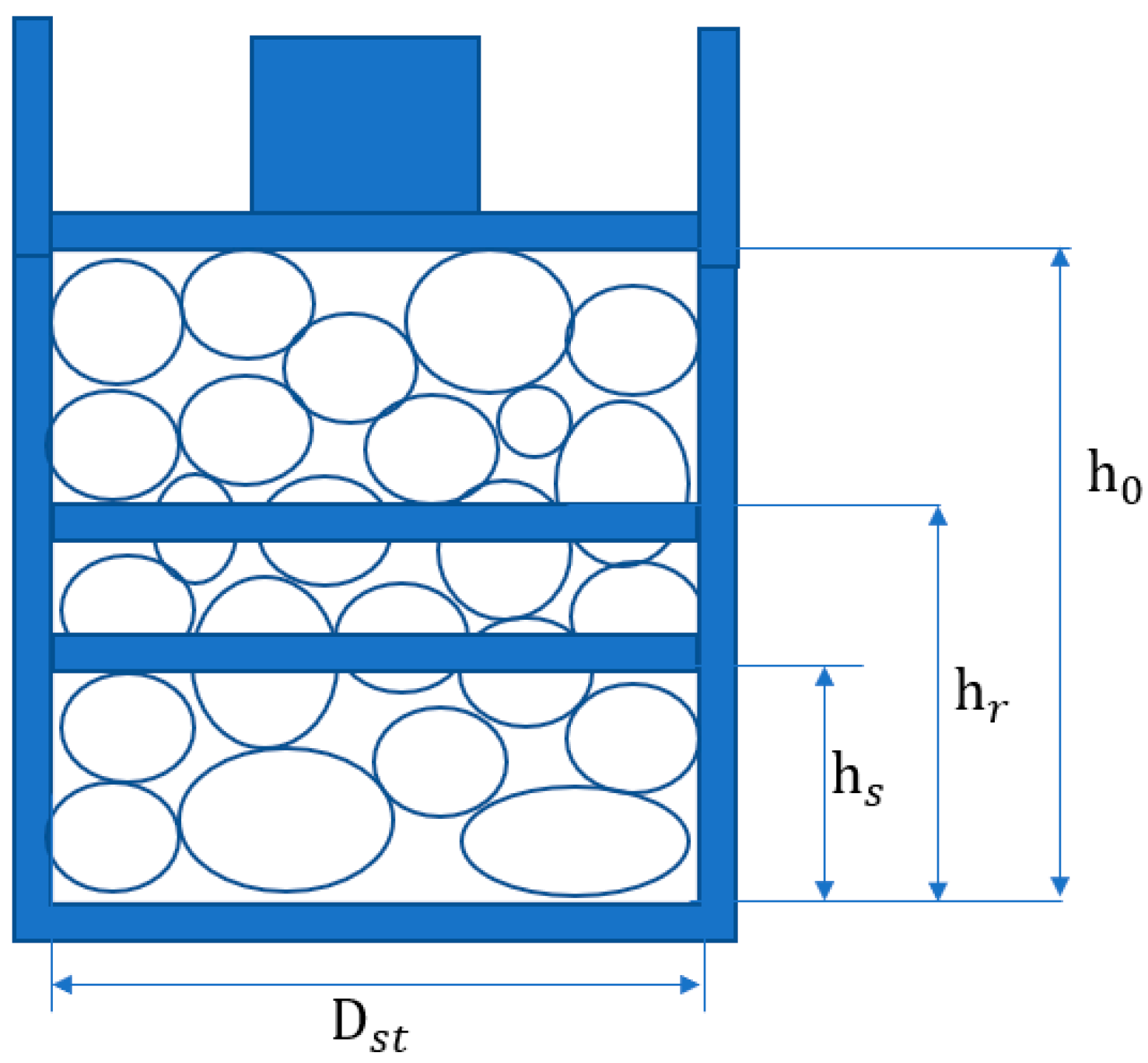
- —The pressure acting on the material during the rebound stage;
- —Relative density at the end of the compression stage;
- —Relative density at the end of the rebound stage, ;
- —Material rebound rate;
- k—rebound factor.
2.2. Mathematical Model of Roller Press
- —The surface pressure of the roller press corresponding to the nip angle () of the roller press;
- Z—The distance from a point on the surface of the roller press to the middle of the roller press;
- m—Pressure axial distribution coefficient, m 1.
- (1)
- Acceleration zone
- (2)
- Compression area
- (3)
- Rebound area
- —The sum of the upper surface areas of all studs;
- —Outer surface area of rolls surface;
3. FEM Simulation
3.1. Contact Analysis of Studded Rolls
Static Analysis of Studded Rolls
3.2. Contact Analysis of Stud-Lining
3.2.1. Simulation Analysis of Studs and Stud-Lining
- (1)
- Stress distribution of studded rolls press in working area
- (2)
- Stress changes in different assembly method
- (3)
- Stress changes in different axial and circumferential distances
- (4)
- Stress changes in different lengths of stud
3.2.2. Initial Optimization Design of Stud-Lining
4. Conclusions
- Based on the compression and rebound characteristics of the material layer, the surface pressure of the roller press was calculated. Optimize the pressure calculation method suitable for the studded rolls surface. Through the FEM, the contact pressure and equivalent stress of the roller shaft and the stud-lining are calculated, compared with the theoretical calculation values, and the roller shaft and the stud-lining are further optimized. The contact pressure between the roller shaft and the stud-lining is reduced.
- The change of equivalent stress between stud and stud-lining in different nip angle of studded rolls are analyzed. It is found that the maximum equivalent stress between stud and stud-lining occurs at the minimum gap between the two rolls and is symmetrically distributed on both sides. The assembling method between the stud and the stud-lining, the distance between the studs, the length of the stud and the height of the stud above the stud-lining are simulated and calculated. The influence of them on the stress of the studs and the stud-lining are analyzed.
- Optimize the design by combining the assembly method of studs and stud-lining, the distance between studs, and the height of studs above the stud-lining. After optimizing the design, the maximum equivalent stress of the stud and the stud-lining is effectively reduced. It provides a theoretical basis for optimizing the rolls surface of studded rolls.
Author Contributions
Funding
Institutional Review Board Statement
Informed Consent Statement
Data Availability Statement
Acknowledgments
Conflicts of Interest
References
- Abouzeid, A.-Z.M.; Fuerstenau, D.W. Grinding of mineral mixtures in high-pressure grinding rolls. Int. J. Miner. Process. 2009, 93, 59–65. [Google Scholar] [CrossRef]
- Rashidi, S.; Rajamani, R.K.; Fuerstenau, D.W. A Review of the Modeling of High Pressure Grinding Rolls. KONA Powder Part. J. 2017, 34, 125–140. [Google Scholar] [CrossRef]
- Tavares, L.M. Particle weakening in high-pressure roll grinding. Miner. Eng. 2004, 18, 651–657. [Google Scholar] [CrossRef]
- Dundar, H.; Benzer, H.; Aydogan, N. Application of population balance model to HPGR crushing. Miner. Eng. 2013, 50–51, 114–120. [Google Scholar] [CrossRef]
- Aydoğan, N.A.; Ergün, L.; Benzer, H. High pressure grinding rolls (HPGR) applications in the cement industry. Miner. Eng. 2006, 19, 130–139. [Google Scholar] [CrossRef]
- Ghorbani, Y.; Mainza, A.N.; Petersen, J.; Becker, M.; Franzidis, J.-P.; Kalala, J.T. Investigation of particles with high crack density produced by HPGR and its effect on the redistribution of the particle size fraction in heaps. Miner. Eng. 2013, 43–44, 44–51. [Google Scholar] [CrossRef]
- Ruonan, M.; Qinglin, Z.; Miaomiao, W.; Quanming, L.; Mingkai, Z. A Survey and Analysis on Electricity Consumption of Raw Material Mill System in China Cement Industry between 2014 and 2019. Sustainability 2021, 13, 1126. [Google Scholar]
- Genç, Ö.; Benzer, A.H. Effect of High Pressure Grinding Rolls (HPGR) pre-grinding and ball mill intermediate diaphragm grate design on grinding capacity of an industrial scale two-compartment cement ball mill classification circuit. Minerals Engineering 2016, 92, 47–56. [Google Scholar] [CrossRef]
- Sesemann, Y.; Broeckmann, C.; Höfter, A. A new laboratory test for the estimation of wear in high pressure grinding rolls. Wear 2013, 302, 1088–1097. [Google Scholar] [CrossRef]
- Van Der Meer, F.P.; Gruendken, A. Flowsheet considerations for optimal use of high pressure grinding rolls. Miner. Eng. 2010, 23, 663–669. [Google Scholar] [CrossRef]
- Barrios, G.K.P.; Tavares, L.M. A preliminary model of high pressure roll grinding using the discrete element method and multi-body dynamics coupling. Int. J. Miner. Process. 2016, 156, 32–42. [Google Scholar] [CrossRef]
- Rodriguez, V.A.; Barrios, G.K.P.; Bueno, G.; Tavares, L.M. Coupled DEM-MBD-PRM simulations of high-pressure grinding rolls. Part 1: Calibration and validation in pilot-scale. Miner. Eng. 2022, 177, 107389. [Google Scholar] [CrossRef]
- Rodriguez, V.A.; Barrios, G.K.P.; Tavares, L.M. Coupled DEM-MBD-PRM simulations of high-pressure grinding rolls. Part 2: Investigation of roll skewing. Miner. Eng. 2022, 178, 107428. [Google Scholar] [CrossRef]
- Chengwei, Z.; Yudong, Z.; Dazhao, G.; Aibing, Y.; Runyu, Y. Experimental and numerical investigation of particle size and particle strength reduction in high pressure grinding rolls. Powder Technol. 2022, 410, 117892. [Google Scholar]
- Zou, Y.; Zhang, C.; Gou, D.; Cheng, G.; Yang, R. DEM analysis of wear evolution and its effect on the operation of a lab-scale HPGR mill. Miner. Eng. 2023, 204, 108401. [Google Scholar] [CrossRef]
- Cleary, P.W.; Sinnott, M.D. Axial pressure distribution, flow behaviour and breakage within a HPGR investigation using DEM. Miner. Eng. 2021, 163, 106769. [Google Scholar] [CrossRef]
- Anticoi, H.; Guasch, E.; Oliva, J.; Alfonso, P.; Bascompta, M.; Sanmiquel, L. High-pressure grinding rolls: Model validation and function parameters dependency on process conditions. J. Mater. Res. Technol. 2019, 8, 5476–5489. [Google Scholar] [CrossRef]
- Esnault, V.; Michrafy, A.; Heitzmann, D.; Michrafy, M.; Oulahna, D. Processing fine powders by roll press. Powder Technol. 2015, 270, 484–489. [Google Scholar] [CrossRef]
- Alex, T.; Jocelyn, B.; André, D. An off-line state observer of the slip, shear stress, and pressure profiles in the high-pressure grinding rolls crusher working gap. Adv. Powder Technol. 2021, 32, 3484–3498. [Google Scholar]
- Pamparana, G.; Klein, B. A methodology to predict the HPGR operational gap by using piston press tests. Miner. Eng. 2021, 166, 106875. [Google Scholar] [CrossRef]
- Lim, W.I.L.; Weller, K.R. Some benefits of using studded surfaces in high pressure grinding rolls. Miner. Eng. 1999, 12, 187–203. [Google Scholar] [CrossRef]
- Rashidi, S.; Diedenhofen, S.; Simmons, A. Implementation of Studded Roll Bodies for Raw Material HPGR Grinding System. In Proceedings of the 2021 IEEE-IAS/PCA Cement Industry Technical Conference, IAS/PCA 2021, Virtual, 24–28 May 2021. [Google Scholar]
- Saramak, D.; Foszcz, D.; Gawenda, T.; Konieczny, A.; Pawlos, W. Influence of type of lining in highpressure grinding rolls on effectiveness of copper ore comminution. Physicochem. Probl. Miner. Process. 2016, 52, 182–192. [Google Scholar] [CrossRef]
- Oberheuser, G. Wear protection of surfaces from high pressure grinding rolls: Possibilities and limits. Int. J. Miner. Process. 1996, 44, 561–568. [Google Scholar] [CrossRef]
- Kazerani Nejad, R.; Sam, A. The wear pattern in high pressure grinding rolls. Miner. Process. Extr. Metall. 2016, 126, 238–244. [Google Scholar] [CrossRef]
- Nagata, Y.; Tsunazawa, Y.; Tsukada, K.; Yaguchi, Y.; Ebisu, Y.; Mitsuhashi, K.; Tokoro, C. Effect of the roll stud diameter on the capacity of a high-pressure grinding roll using the discrete element method. Miner. Eng. 2020, 154, 106412. [Google Scholar] [CrossRef]
- Uttarwar, K.; Sonawwanay, P.D.; Bhosale, S. Finite element analysis of high-pressure grinding rolls for crack prediction to determine safe working conditions. Mater. Today Proc. 2022, 56, 2952–2959. [Google Scholar] [CrossRef]
- Weihua, W.; Fangxu, P.; Yingli, L.; Bingrui, C.; Yiqi, X.; Yu, W. Optimization Design of Extrusion Roller of RP1814 Roller Press Based on ANSYS Workbench. Appl. Sci. 2021, 11, 9584. [Google Scholar]
- Michrafy, A.; Diarra, H.; Dodds, J.A.; Michrafy, M.; Penazzi, L. Analysis of strain stress state in roller compaction process. Powder Technol. 2011, 208, 417–422. [Google Scholar] [CrossRef]
- Alex, T.; Jocelyn, B.; André, D. A steady-state model of the high-pressure grinding rolls. IFAC PapersOnLine 2020, 53, 11830–11835. [Google Scholar]
- Dec, R.T.; Zavaliangos, A.; Cunningham, J.C. Comparison of various modeling methods for analysis of powder compaction in roller press. Powder Technol. 2003, 130, 265–271. [Google Scholar] [CrossRef]
- Yehia, K.A. Estimation of roll press design parameters based on the assessment of a particular nip region. Powder Technol. 2007, 177, 148–153. [Google Scholar] [CrossRef]

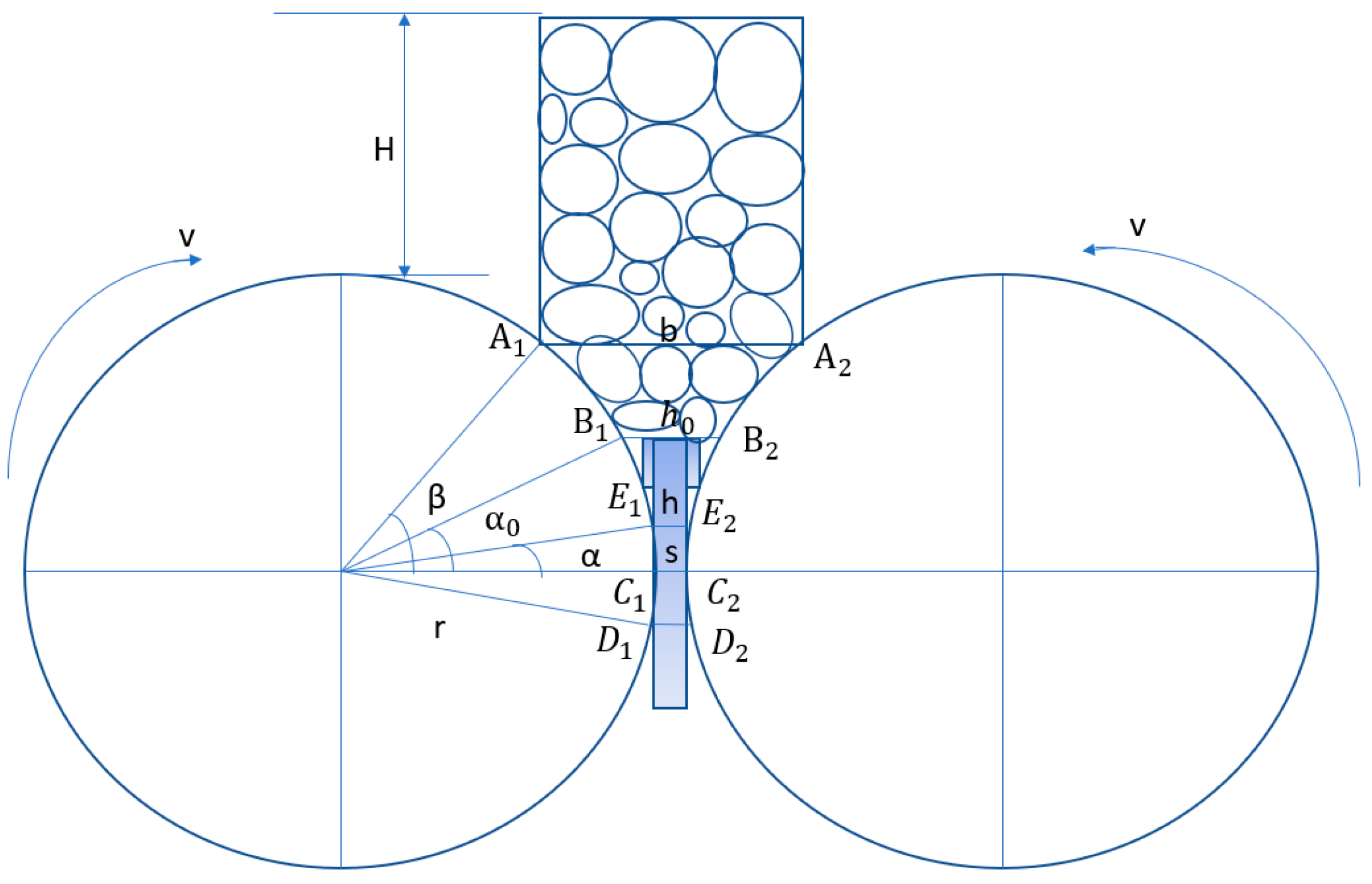
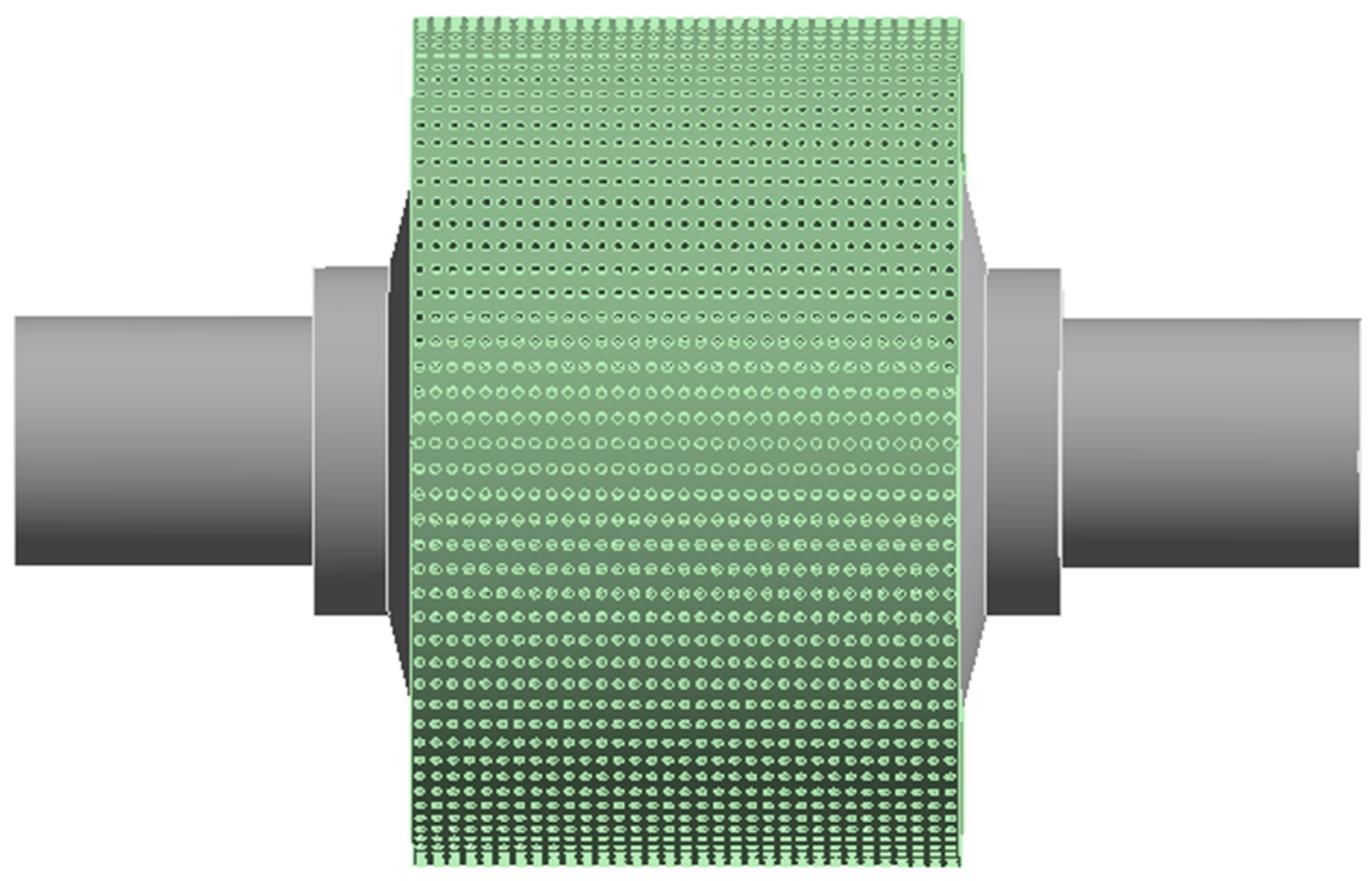

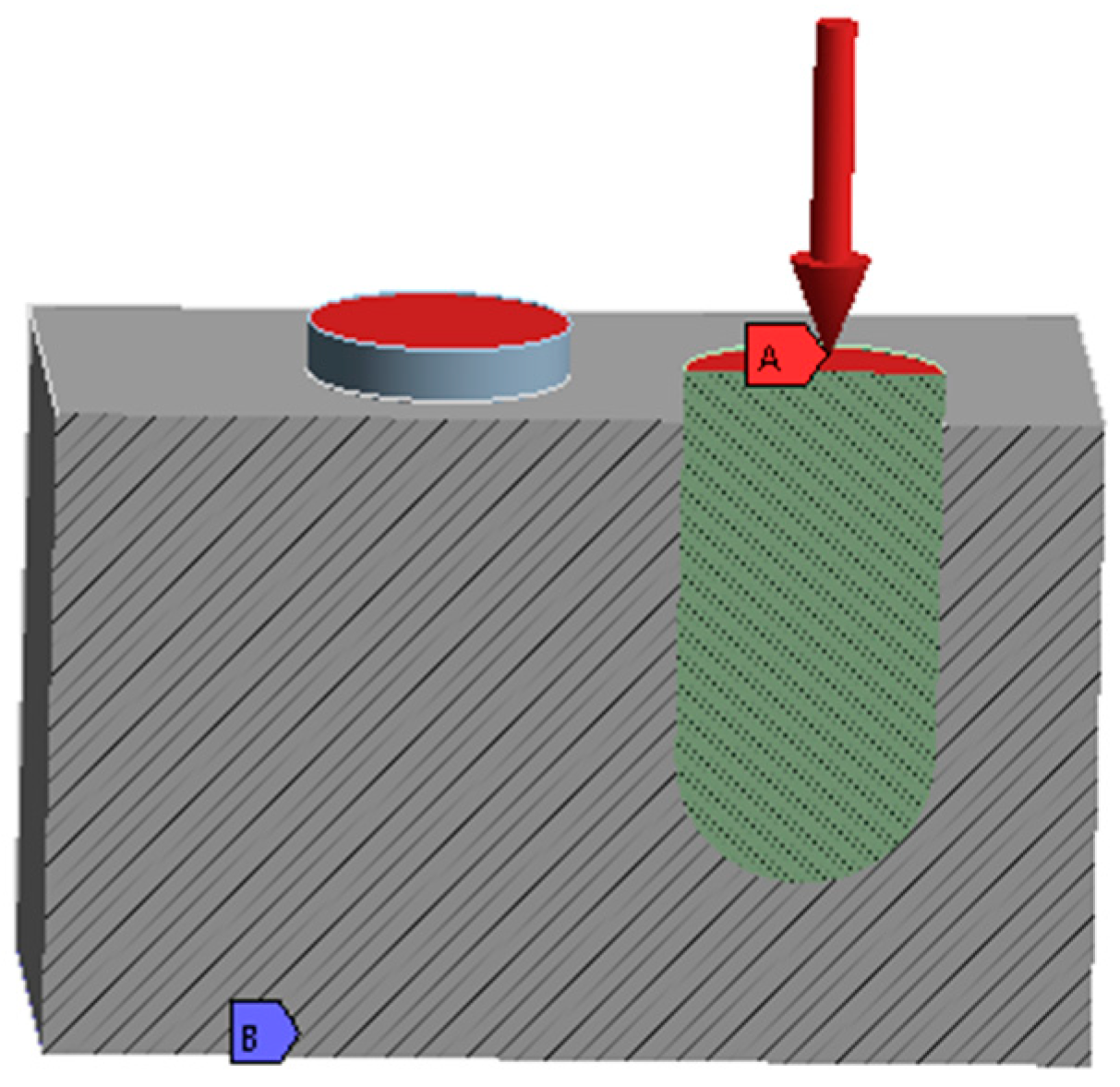
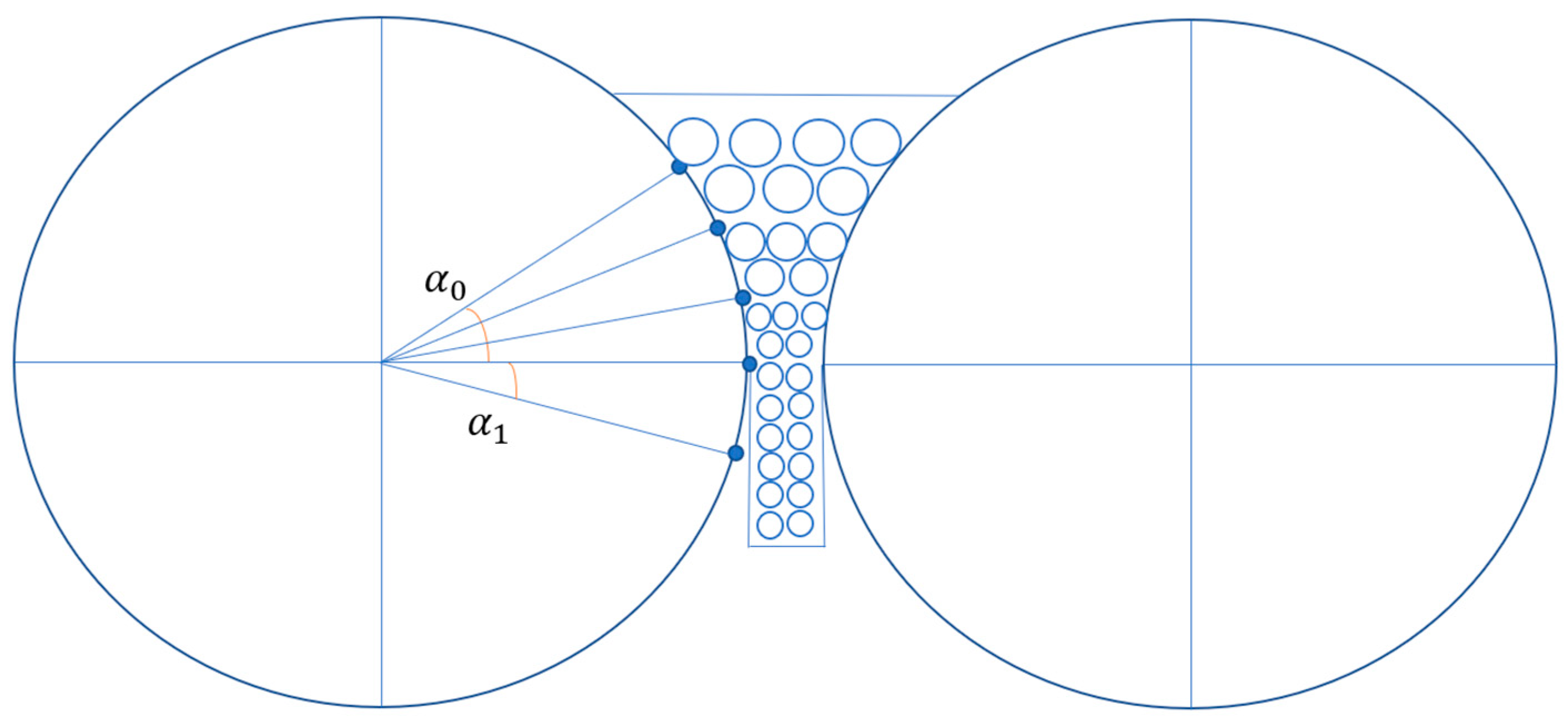


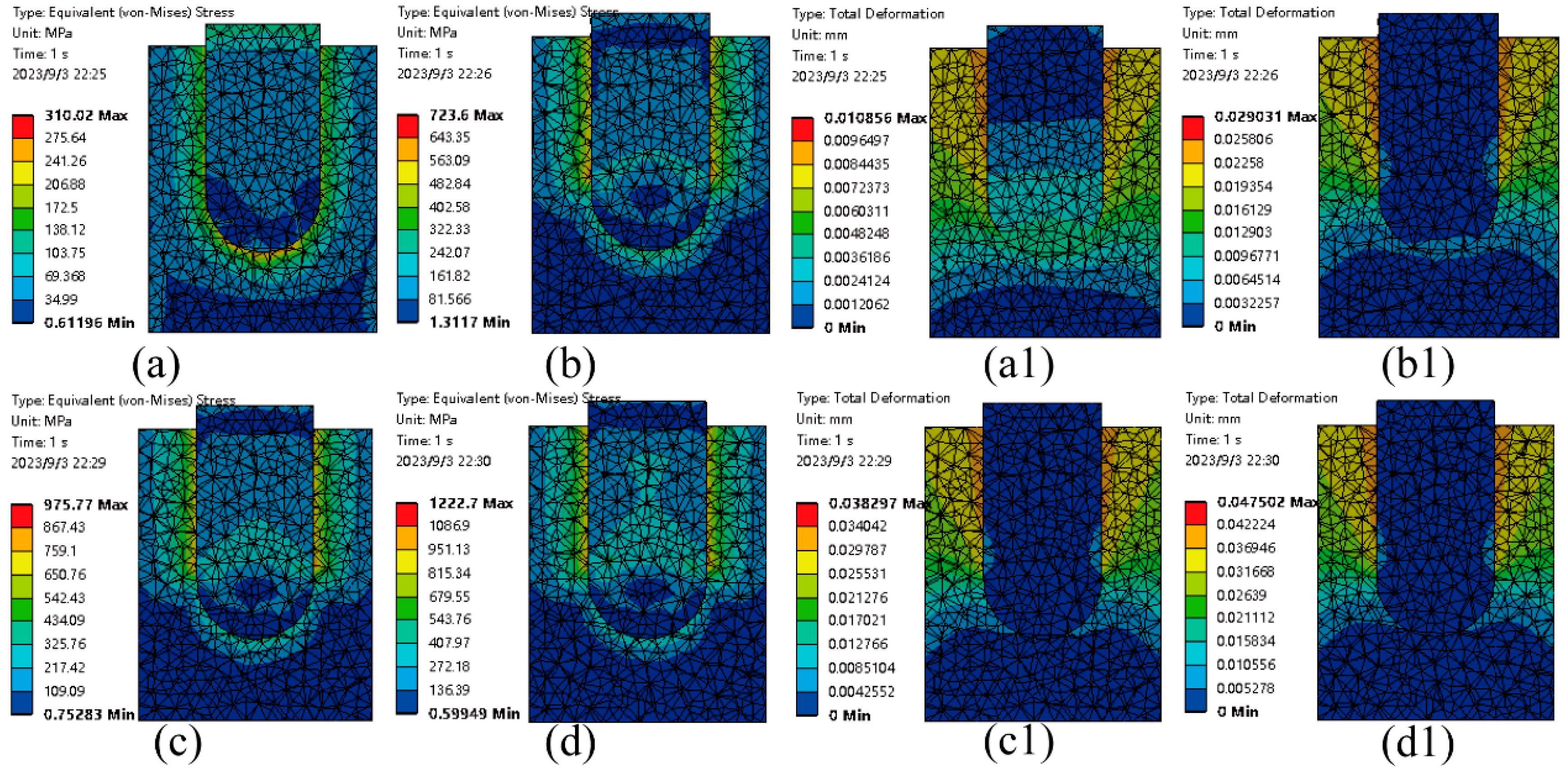
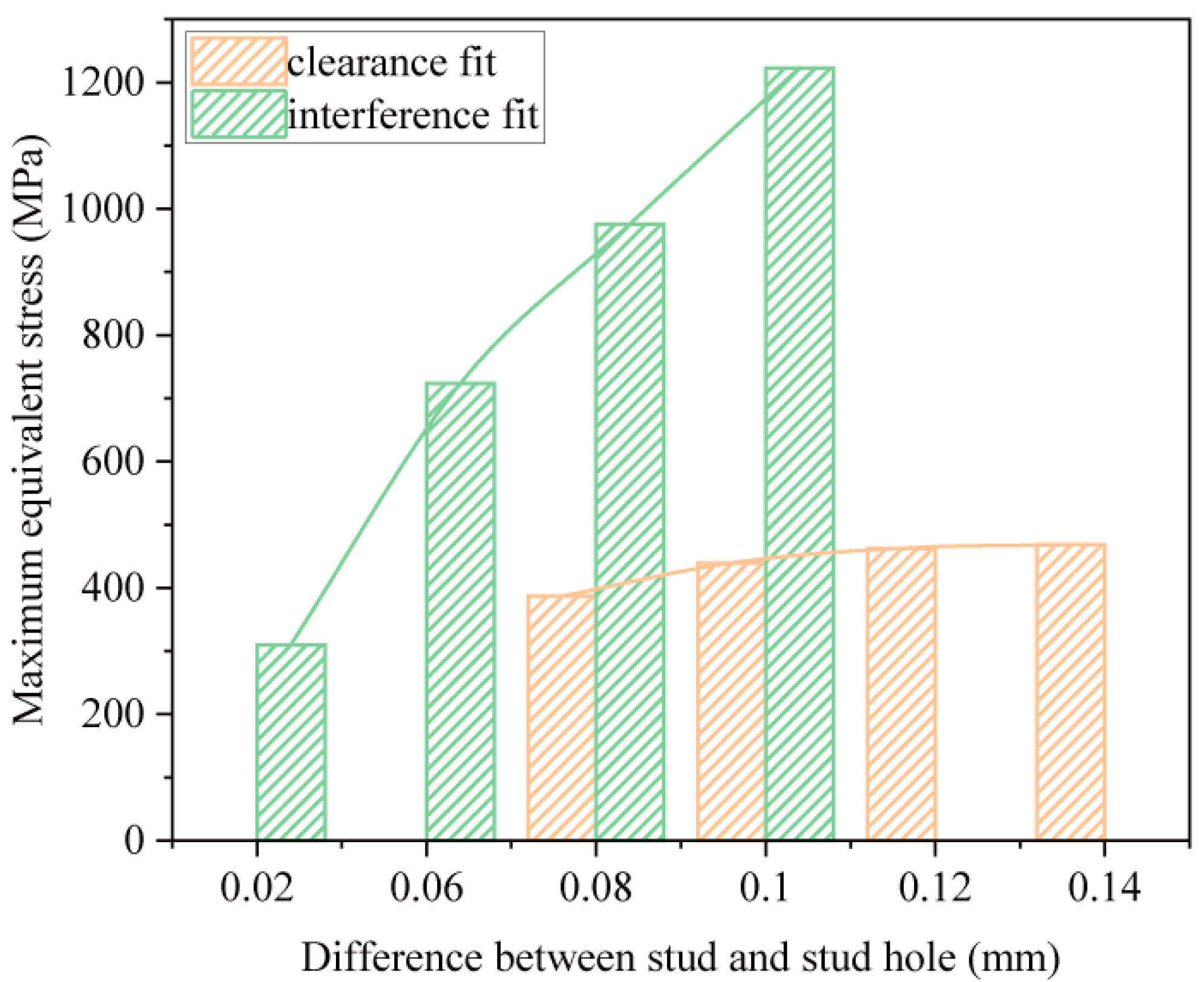
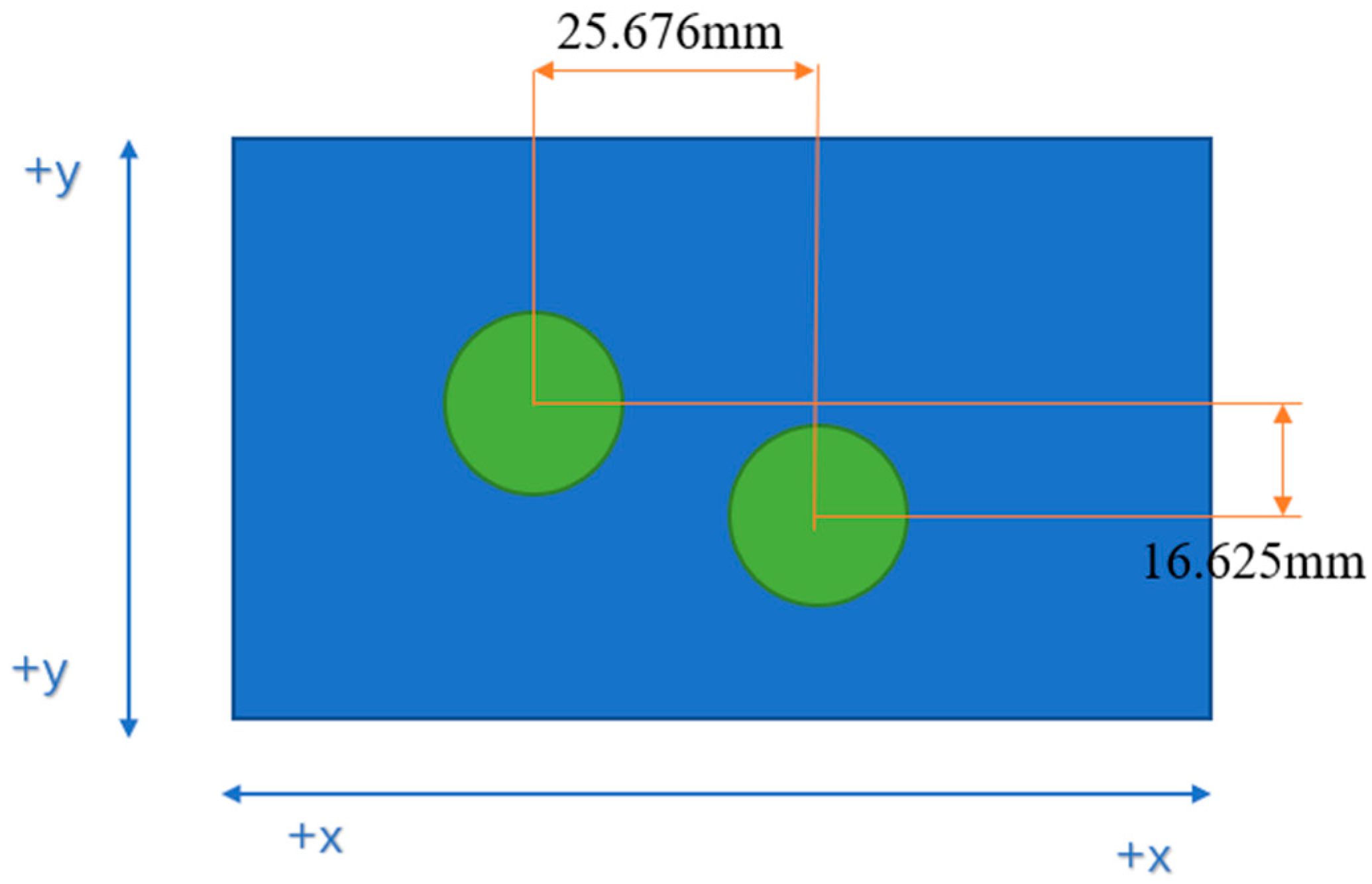




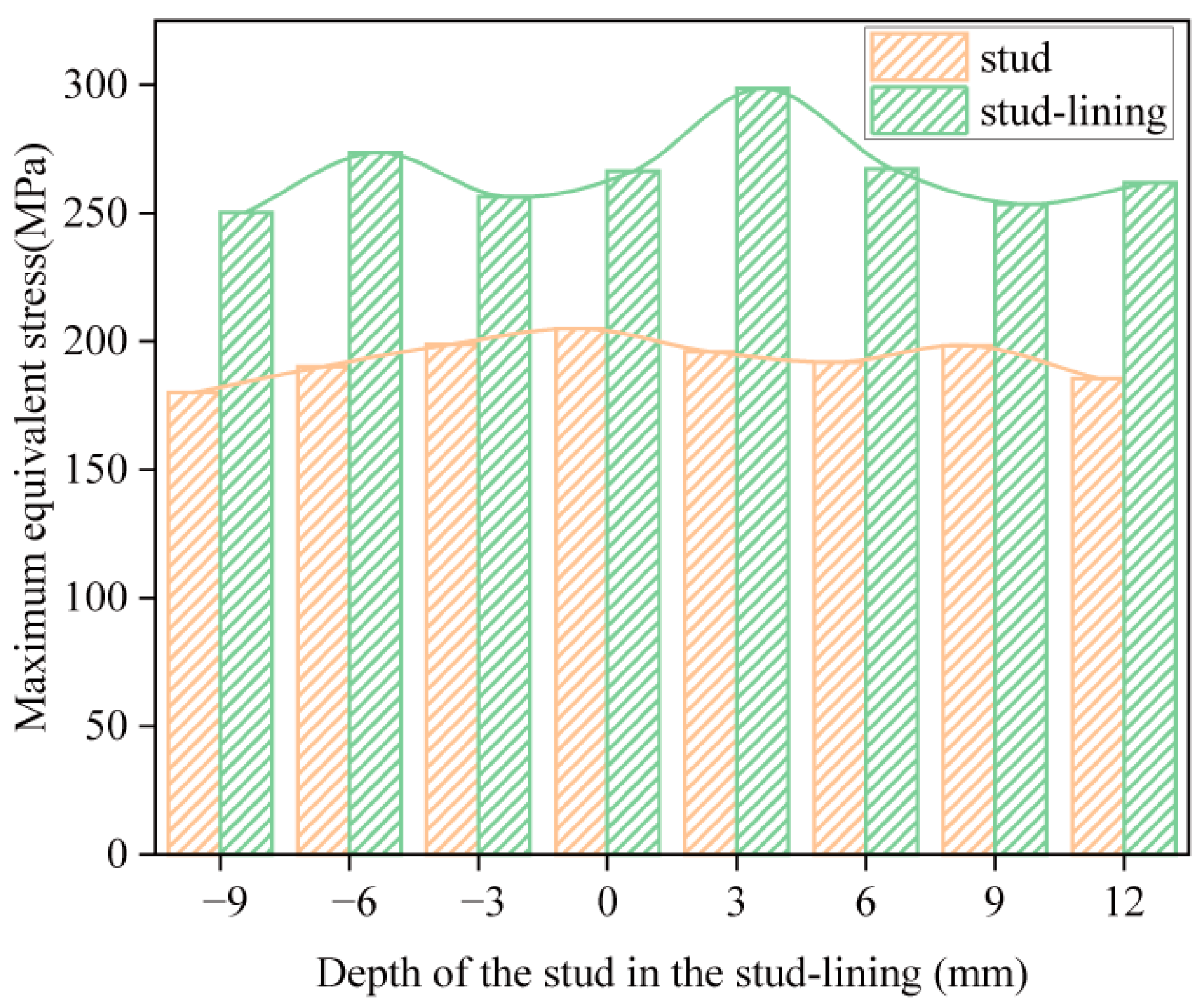


| p(α, λ) | p1(α, λ) | ||
|---|---|---|---|
| 0 | −2 | 3.177328295 | 4.32116648 |
| −1 | 45.82270455 | 62.3188781 | |
| 0 | 93.64323785 | 127.354803 | |
| 1 | 67.15816728 | 91.3351075 | |
| 2 | 26.67192213 | 36.2738141 | |
| 3 | 6.725000976 | 9.14600132 | |
| 4 | 1.160455023 | 1.57821883 | |
| 5 | 0.130027849 | 0.17683787 | |
| 6 | 0.007028457 | 0.00955870 |
| Part | Density (kg/m3) | Elastic Modulus (Pa) | Poisson’s Ratio μ | Yield Strength (MPa) |
|---|---|---|---|---|
| Roller Shaft | 7850 | 2.12 × | 0.280 | 930 |
| Stud-lining | 7850 | 2.10 × | 0.275 | 835 |
| Stud | 10,000 | 6.05 × | 0.275 | 600 |
Disclaimer/Publisher’s Note: The statements, opinions and data contained in all publications are solely those of the individual author(s) and contributor(s) and not of MDPI and/or the editor(s). MDPI and/or the editor(s) disclaim responsibility for any injury to people or property resulting from any ideas, methods, instructions or products referred to in the content. |
© 2023 by the authors. Licensee MDPI, Basel, Switzerland. This article is an open access article distributed under the terms and conditions of the Creative Commons Attribution (CC BY) license (https://creativecommons.org/licenses/by/4.0/).
Share and Cite
Wang, F.; Du, J.; Su, G. Investigation of Roller Press Surface and Stud Based on FEM Simulation. Appl. Sci. 2023, 13, 11032. https://doi.org/10.3390/app131911032
Wang F, Du J, Su G. Investigation of Roller Press Surface and Stud Based on FEM Simulation. Applied Sciences. 2023; 13(19):11032. https://doi.org/10.3390/app131911032
Chicago/Turabian StyleWang, Fulin, Jin Du, and Guosheng Su. 2023. "Investigation of Roller Press Surface and Stud Based on FEM Simulation" Applied Sciences 13, no. 19: 11032. https://doi.org/10.3390/app131911032
APA StyleWang, F., Du, J., & Su, G. (2023). Investigation of Roller Press Surface and Stud Based on FEM Simulation. Applied Sciences, 13(19), 11032. https://doi.org/10.3390/app131911032







